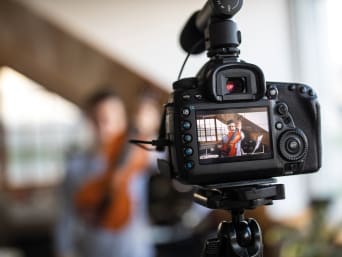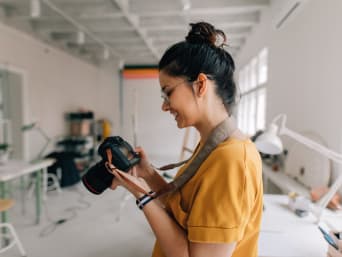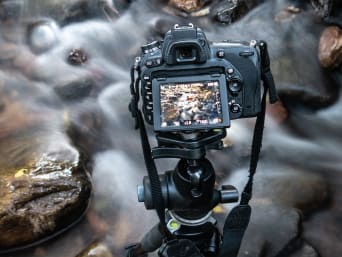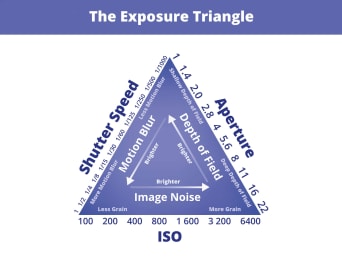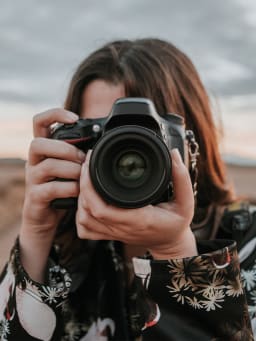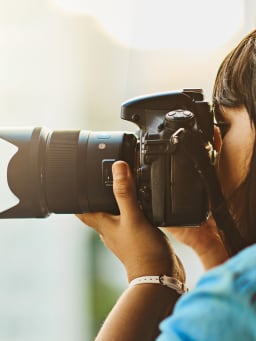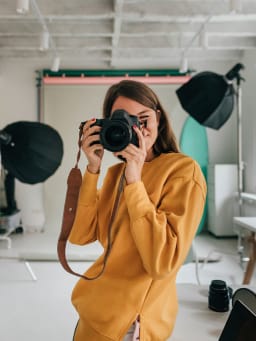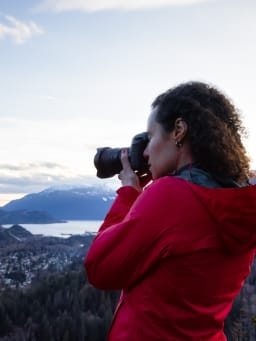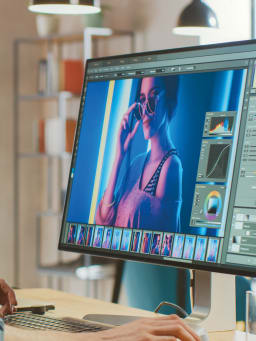Learning how to take good pictures: basics, camera settings & tips on image composition
It is recommended to familiarise yourself with the basics of photography in order to take good photos and to be able to take full advantage of the creative possibilities on your camera. Choosing the right camera settings can help you design your photos how you have envisaged them. This also gives you the freedom to get really creative. In this article you will find tips on photography basics for beginners as well as some tips on image composition. These tips will help you to get started and learn more about photography.
Brief explanation of photography basics & the different camera settings
If you are using a camera for the first time, you will be amazed at how many features and options it has. Suddenly, terms like focal length, aperture and ISO play a role in taking the best possible photos. To help you find your way around the different camera settings and to take well exposed and sharp pictures with your first camera, you will find a short introduction to the basics of photography below.
Using white balance for natural lighting
Let's start with one of the less complex camera settings. The white balance controls the colour temperature. The lighting is always different depending on whether you are shooting outdoors or indoors, in the sun or in the rain. We usually don't notice this with the naked eye, but your camera perceives the colours differently.
By using the white balance you can adjust your camera so that the colours and lighting mood always look natural. A lot of cameras nowadays have an automatic function that you can try out. You have a little more freedom if you use the semi-automatic white balance. Depending on the camera, you can choose between different light settings (e.g. daylight, cloudy sky, artificial light, winter, etc.). If you do not like the white balance you can change it later whilst editing your photos.
Focal length and the angle of view of your photos
The focal length is indicated on your lens in mm and shows which angle of view is available for your photo. A distinction is made between the different types:
Normal focal length (35 - 70 mm): the normal focal length represents the angle of view that we can also capture through our eyes.
Wide-angle (11 - 28 mm): wide-angle lenses can depict a larger angle of view. For this type of image, a person would have to turn their head to be able to see everything. This way you can show whole areas of a photo.
Telephoto lens (80 - 500 mm): a telephoto lens magnifies subjects and allows you to capture objects in sharp detail even from a long distance.
To capture all the details of a subject, you need to choose the right lens with the appropriate focal length. For example, a wide-angle lens is recommended for landscape photography. If you would like to take photos of flying birds a telephoto lens is suitable and a normal focal length for portraits.
ISO settings on a camera: finding the right lighting
The ISO value shows you how sensitive the camera sensor is to light. If the ISO value is low, then the sensor will take in less light and if the ISO value is high, then the sensor will take in more light. This allows you to adapt your camera to the lighting, which gives you more freedom when setting the shutter speed and aperture.
However, you should be aware of the higher the ISO value of the camera is , the more this can lead to image noise. It is therefore not recommended to just change the ISO value.
To take great noise-free photos it is best to set the ISO on the lowest possible setting. The ISO value settings on a camera can help you learn how to take photos:
Taking photos in the sun: 100 - 200 ISO
Taking photos with an overcast sky, in the evening or indoors without a flash: 400 - 800 ISO
At night or in dark rooms: more than 800 ISO

If in doubt, underexpose your photos a little. You can then brighten them up again afterwards by editing them. If your picture is overexposed, you cannot edit or change the overexposed areas of the photos afterwards.
Camera shutter speed: how long is your photo exposed?
The shutter speed is also called exposure time and this determines for how long light will be on the sensor. The shutter speed is given in seconds or fractions of seconds (e.g. 1/1000 s). The shutter speed affects how your subject appears in the photo:
Fast shutter speed: captures a moving subject. If you would like to capture fast movements and get a sharp image, the shutter speed must be correspondingly fast: e.g. a flying hummingbird at 1/4000 s or a runner at 1/120 s.
Long shutter speed: blurs the movement, creating a motion blur. Some examples of this are: a waterfall which is created at 10 s shutter speed or the way stars move which becomes visible in a photo from 30 s to several hours of exposure time.
If there is no available bright light because you are taking photos indoors, in the evening or at night then you should select a longer exposure time in the camera settings. However, it is important to remember that a longer exposure time increases the risk of your photo becoming blurry. Therefore, it is recommended to use a tripod for longer exposure times.

If you don't have a tripod, you can easily work out whether you can hold the camera for a given amount of time to take a photo of the subject with the set exposure time. The formula is: exposure time = reciprocal of the focal length. An example of this would be, if you use a 50 mm standard focal length, you can still take a photo of the subject without an image stabiliser and tripod with an exposure time of 1/50 s.
Camera aperture: setting the depth of field
The aperture determines how much light will pass through the camera lens and onto your camera’s sensor. If you have the aperture on one of the lowest settings, then the aperture will be wide open, and a lot of light will be passed onto the sensor. The larger the aperture value, the more the lens will be closed which means there will be less light reaching the sensor.
Depending on how much light will be on the camera sensor will then influence how sharp the background of your photo will be. This is one of the most important design elements in photography. If you have set the aperture to a low setting and a lot of light is passed onto your camera sensor the result will be a blurry background. If on the other hand, you have set the aperture to a higher setting and not a lot of light is passed onto the camera sensor the result will be a very sharp background.
By using the aperture on your camera settings, you can get the following effects:
Pop-out effect with a very blurred background: f/2,0
Portrait photos: f/3,5
Landscape photo: f/20
A photo will full details: f/8
Learning how to take photos: correctly exposing photos by using aperture, shutter speed and ISO
You will need to expose your photos correctly and make sure that you have found the perfect combination for the aperture, shutter speed and ISO to get the perfect shot you have been thinking about. These three elements are all connected to one another, and they also have an influence on how your photos will turn out.
If you would like to take a photo where the background is blurred, and the subject is in focus you will need to adjust the depth of field and make sure that your aperture is wide open. By using a wide-open aperture more light will pass through and onto the sensor at the same exposure time than with a closed aperture. Therefore, you have to adjust the exposure time to the open aperture and shorten it accordingly. The ISO value will determine how bright or dark your image will be, depending on how light-sensitive your sensor is. It is recommended to keep the ISO value as low as possible and to set the exposure time via the aperture and the shutter speed because a high ISO value causes image noise.
The Exposure Triangle helps to give you a good idea on how to take great photos. If you change one of the values, e.g. the aperture, you must also adjust the shutter speed and the ISO value accordingly. To find the right camera setting, start with your desired image composition, e.g. depth of field or motion blur, and then adjust the other values.
An example: you will need to have the shutter speed on a fast setting if you would like to take a picture of a person running. However, if you would like to take a photo of a runner and capture their movement you will need to keep your aperture closed in order to get the background in focus and you will have to increase the shutter speed again. However, if you want to keep your aperture closed so that the background is also in focus, you will need to increase the ISO value, which can lead to image noise.

A lot of cameras have automatic programmes for aperture and shutter speed. In aperture priority mode you can adjust the aperture manually, while the camera automatically determines the appropriate shutter speed and the lowest possible ISO value. In shutter priority mode, you can change the exposure time and the camera will select the appropriate aperture. This is a great way to make your camera settings easier to use.
How to take great photos: tips on image composition
In addition to the basics on exposing your photos correctly, there are also some simple rules that you can follow for photo composition to take great photos. These tips are especially helpful for beginners as these tips can help you to take some fantastic photos:
Rule of thirds: having a grid displayed in the viewfinder on your camera can help you to compose a great picture. You can use the lines to divide your subject into three parts, which has a great effect. In addition, you can place your subject at one of the four intersections to draw attention to it. The lines also help you to align your motif and find the centre.
Designing your foreground: a full foreground helps to add depth to your photo and makes it even more interesting. Therefore, try to make sure that you always place something in the foreground.
Framing: photo motifs really make them stand out. When taking photos of the countryside you can use hanging branches, a hedge or some rocks as a frame. In urban areas, archways or even groups of people are great to use as frames.
Finding the right direction: photos look great if your eye can still follow the indicated direction, but at the same time there is still room to gaze into the other areas of the photo. For example, if you are taking a photo of a car driving from left to right, you should position the car on the left part of the picture and leave some space on the right, as this will help to show which direction the car was driving in. The photo will then convey that there is enough space for the car to move from left to right.
Take photos at eye level: you will get authentic photos if you take photos of your subjects at eye level. This works well especially if you are taking photos of children or are interested in animal photography. To get a great shot its best to kneel down and be on the same eye level as your subject.
Symmetry and leading lines: whilst taking pictures make sure to look for symmetries in the picture to achieve a harmonious effect. For example, you can make use of any reflections or look for symmetries in buildings or rooms. You can also use leading lines such as railings, columns or pylons to guide the viewer's eyes.
When taking photos, it is also important to keep these rules in mind, but at the same time it is also important to find your own perspective. Therefore, the above tips are more of an aid for photography beginners.
Conclusion: learning how to take photos with the help of some photography tips for beginners
Cameras nowadays have an automatic mode or programmes that make certain settings easier. Nevertheless, it is still a good idea to learn the basics of camera settings and thus learn how to take photos. By doing so, you will understand how your camera works and which options are available for taking photos.
______________________________________________
References
https://capturetheatlas.com/exposure-triangle-explained-photography/#:~:text=The%20exposure%20triangle%20is%20an,get%20a%20perfectly%20exposed%20photo
(last accessed on 25.10.2022)
https://www.format.com/magazine/resources/photography/how-to-take-professional-photos
(last accessed on 25.10.2022)
https://photographylife.com/photography-tips-for-beginners
(last accessed on 25.10.2022)
https://www.shutterfly.com/ideas/photography-for-beginners/
(last accessed on 25.10.2022)
Image soruces
iStock.com/miodrag ignjatovic
iStock.com/AleksandarNakic
iStock.com/nickalbi
iStock.com/petrroudny
